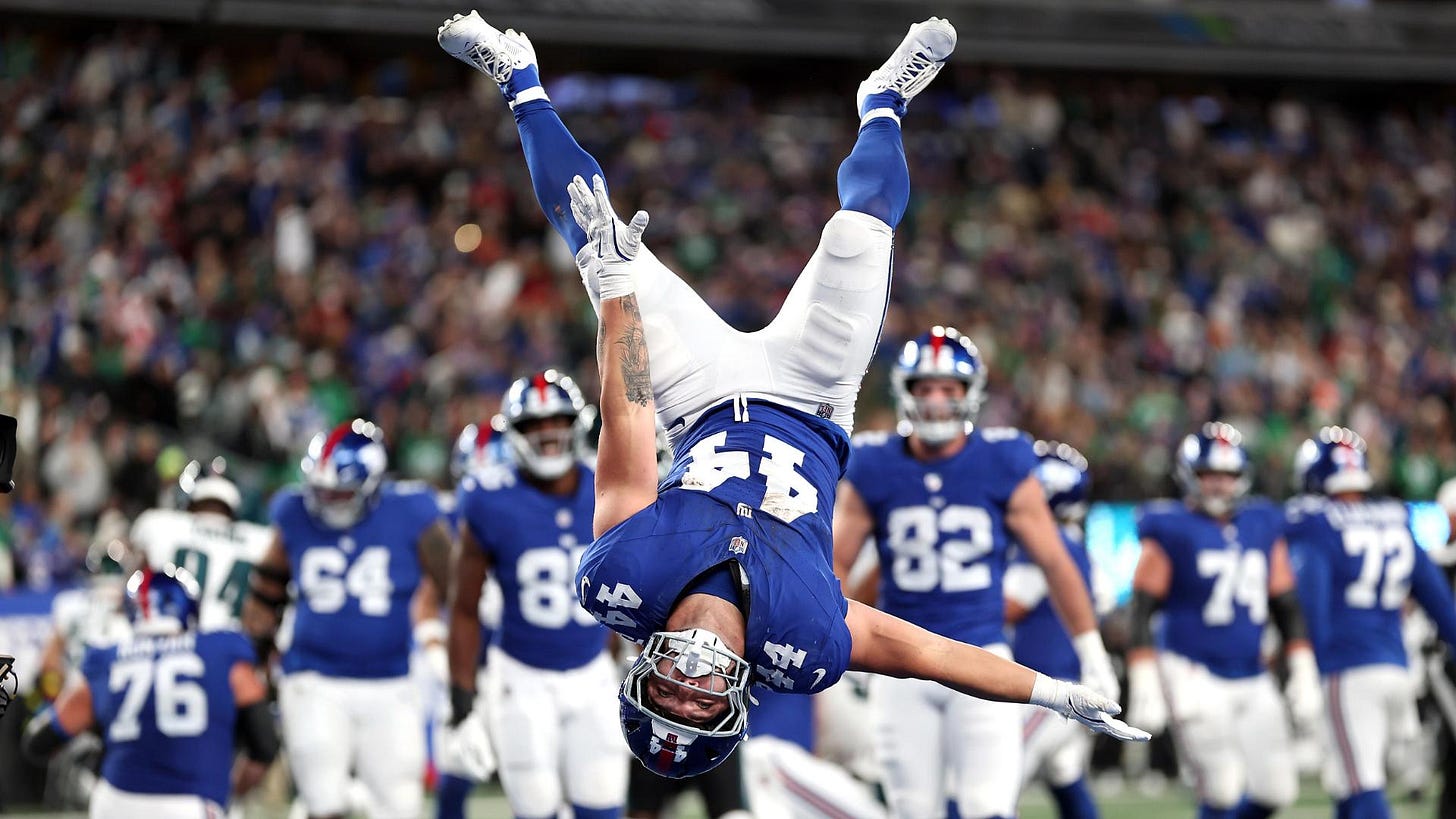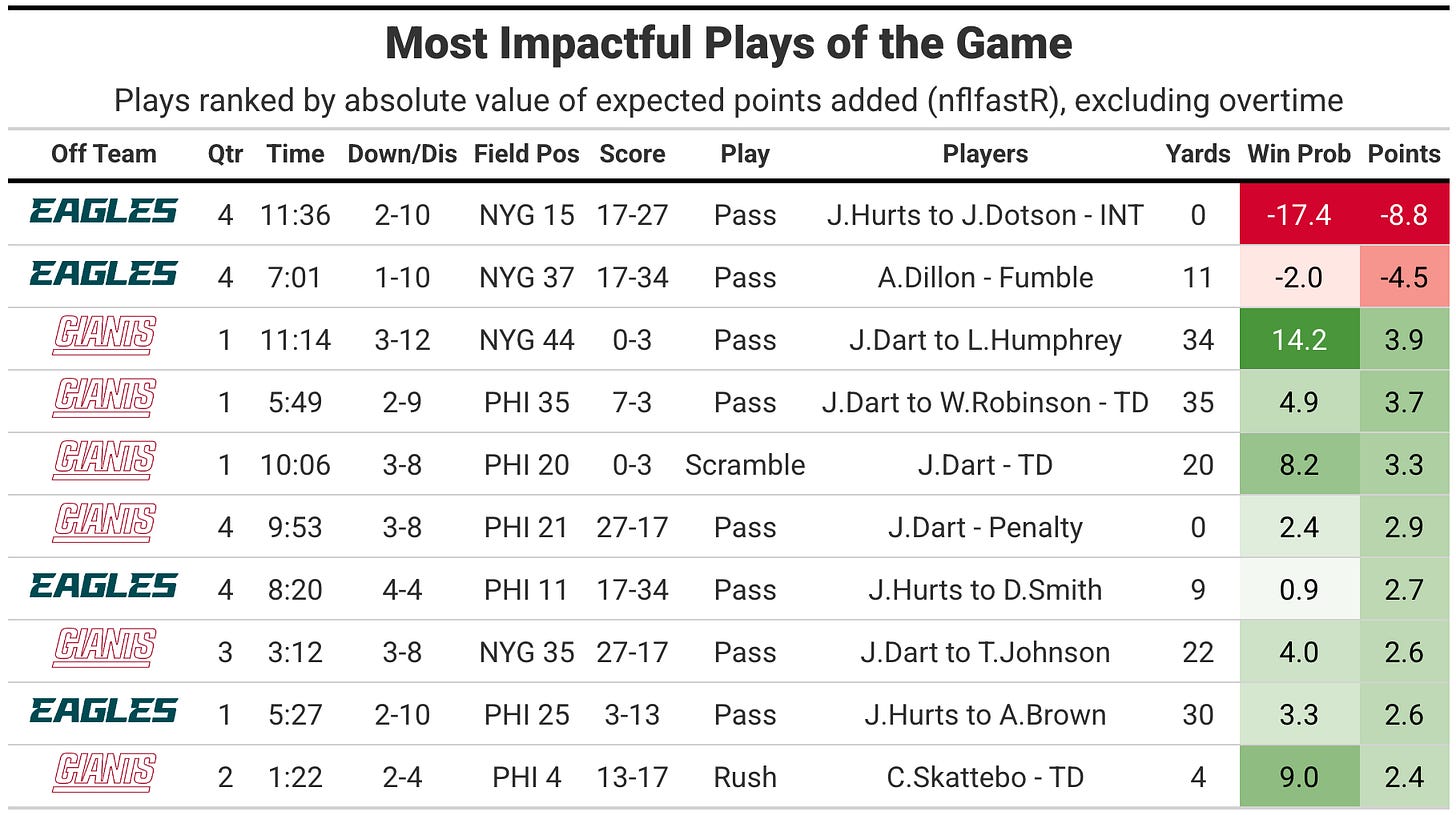Week 6 Thursday Night Giants-Eagles: Advanced Review
The Philadelphia Eagles suffer a crushing defeat to the New York Giants, who may have found their next franchise quarterback
The adjusted scores quantify team play quality, with emphasis on stable metrics (success rate) and downplaying higher variance events (turnovers, special team, penalties, fumble luck, etc). Adjusted expected points added (EPA), in conjunction with opportunity-based metrics like total plays and drives, projects adjusted points. Adjusted scores have been tested against actual scores and offer slightly better predictive ability, though their primary benefit is explanatory.
All 2025-2022 and historical Adjusted Scores and other site metrics are available in a downloadable format to paid subscribers via Google Sheet.
Find previous advanced reviews here
** Adjusted Scores table:
“Pass” - Pass rate over expectation (based on context of each play and historical averages
“Success” - Success rate on offense, a key metric in adjusted score vs actual
“H & A” - Home or away team
NYG vs PHI (-7)
Even as one of the most public Philadelphia Eagles “skeptic”, I didn’t see this awful performance coming. It’s now back-to-back losses for the Eagles, after winning the Super Bowl and starting the season 4-0, which required putting them at the top of all media power rankings (but not mine where they were sixth going into Week 5 and seventh going into this week).
Even my doubts didn’t anticipate the manner in which they lost this game: a horrible defensive effort that made the New York Giants offense look like the 2007 New England Patriots. Okay, the Giants offense wasn’t actually statistically dominant in the fashion of an all-time great, but the Eagles couldn’t get a stop, despite forcing tons of third downs. The Giants offense went 11-for-16 on third down (Eagles were 1-for-9) and all five of their scores were touchdowns.
The other major advantage the Giants had was turnover value differential, holding onto the ball while the Eagles offense made two huge mistakes (total -13.3 EPA), in particular a 2nd & 10 interception from the Giants 15 yard-line that was run back 68 yards in the other direction (-8.8 EPA).
When you put together the flukiness of the Giants touchdown-or-bust offense and inherent instability of turnovers, the win looks a lot less impressive than the final score. The adjusted scores only had the Giants as three points better than the Eagles, reflecting almost identical offensive success rates (Eagles 45.6%, Giants 45.0%).
From the standpoint of traditional stats, the Giants only outgained the Eagles by 27 yards (336 to 339) and actually gained fewer yards per play (5.5 to 6.1). All the numbers point to teams that were fairly evenly matched - the Giants just made the right plays at the right times (third downs) and avoided big mistakes. This is a formula for winning games, but not necessarily something you can count on doing week-in and week-out. You’d prefer a generally more efficient and successful offense, with the assumption things like third-down conversion rates and turnovers will roughly even themselves out over longer samples.
Another somewhat unsustainable feature of the Giants offensive production was its rushing efficiency. Cam Skattebo gained 98 yards and three touchdowns (+7.1 EPA) on 19 carries, while Jaxson Dart added five scrambles for +4.9 EPA and another five designed runs for +0.7 EPA. The Giant posted negative rushing EPA in four of their five previous games.
Incredibly efficient game for rookie Jaxson Dart overall, with the context that much of his value came from rushing gains. That said, his tremendous scrambling ability didn’t come at the cost of sack losses, as he only took two for a single yard lost. Dart also avoided turnovers to help maximize his total EPA value.
One thing to be aware of is the massive early-late down splits for Dart in the game. On first and second down, Dart had negative CPOE (-3.3%), modestly positive efficiency (+0.05 EPA per play) and total value (+1.2 EPA). On third down, Dart was extremely accurate (+18.1% CPOE), efficient (+1.10 EPA per play) and added a ton of total value (+15.4 EPA). I don’t want to be a total downer here on a fun rookie, but it’s something to keep in mind when thinking about what to expect from Dart going forward. If a few more of those good plays come on lower-leverage early downs and mediocre plays come on higher-leverage late downs, then his overall efficiency takes a significant cut.
Flat out too many mistakes for Jalen Hurts, and playing from behind isn’t going to enhance Hurts’ ability to juice value via running the ball (7 carries for 13 yards, +0.1 EPA). The big warning signal flashing earlier this year that had me skeptical of the Eagles was their mediocre offensive numbers, and that concern builds after the last two weeks. I talked a lot going into Week 1 about how you can’t simply bank on defensive efficiency the likes that the Eagles had last season carrying over year-to-year.







